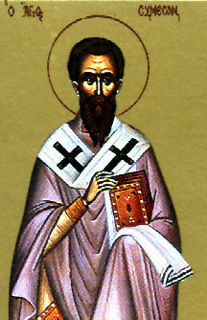Related Research Articles
The 340s decade ran from January 1, 340, to December 31, 349.
Year 345 (CCCXLV) was a common year starting on Tuesday of the Julian calendar. At the time, it was known as the Year of the Consulship of Amantius and Albinus. The denomination 345 for this year has been used since the early medieval period, when the Anno Domini calendar era became the prevalent method in Europe for naming years.

Saint Jacob of Nisibis, also known as Saint Jacob of Mygdonia,, Saint Jacob the Great, and Saint James of Nisibis, was the Bishop of Nisibis until his death.
Saint Abraham (also known as Abraham of Charres and Abraham the Apostle of Lebanon was a Syrian hermit and bishop of Harran. He was born and educated at Carrhae in Syria, and preached the Gospel in the valley of Mount Lebanon, where he lived as a hermit. His life was described by Theodoret of Cyr, the Bishop of Cyrrhus, who named him among the other thirty holy men and women in his book "Historia Religiosa".
Saint Abdecalas was a Persian priest of advanced age who, together with another priest, Saint Ananias, and about a hundred other Christians, was killed under the Persian ruler Shapur II on Good Friday, 345. One of these others was also named Abdecalas.
Abai was a martyr in Syria. He was killed during the reign of Shapur II. He is a saint in the Syriac Orthodox Church and his feast day is October 1. He is included in Kalendarium Manuale Utriusque Ecclesiae Orientalis et Occidentalis. He had been killed by his father Adorpirozgerd who later became a Christian. He was killed together with other 5000 martyrs including his mother Astina (Hwarta). He was mentioned in the legend of Sābā Pirgushnasp, a child martyr, who had been a son of the governor of Beth ʿArabaye and had been killed under the Shapur II. Approximately the years of his life are 335-385 AD.
Abda and Abdjesus were two Christian bishops who were martyred at Kashkar under Shapur II on 16 May, in either 366 AD or 375 AD. They were first placed between heavy boards to crush their bones, and later beheaded.

Mar Shimun Bar Sabbae was an Bishop of Seleucia-Ctesiphon, from Persia, the de facto head of the Church of the East, until his death. He was bishop during the persecutions of King Shapur II of the Sasanian Empire of Iran, and was executed along with many of his followers. He is revered as a saint in various Christian communions.
Chusdazat is the name of a priest and fellow martyr of Bishop Simeon Barsabae. He was a eunuch of King Shapur II.
Desan was a bishop of the Christian Church.
Abdisho, a member of the Church of the East, was a deacon and martyr.
Dausa was a bishop and martyr of the Christian church.
Zanitas and Lazarus of Persia were martyrs of the Christian church.
Acepsimas of Hnaita was a bishop, martyr and saint.
For the martyr of 447 in Bet-Titta, see Simon of Bet-Titta.
Sapor of Bet-Nicator was the Christian bishop of Bet-Nicator.
Barhadbesciabas is venerated as a Christian martyr who was decapitated during the reign of Shapur II. A deacon of Arbela, in the Sassanid Empire, he was arrested by the governor of Arbela, Sapor Tamaspor, and put on the rack.
Saint Abraham, is a Persian saint from the 4th century AD. Abraham was one of the four companions of Sapor of Bet-Nicator, a Christian bishop of Bet-Nicator.

November 30 - Eastern Orthodox liturgical calendar - December 2

The Chronicle of Arbela claims to record the early history of Christianity in the city which is now known as Erbil, Iraqi Kurdistan, but which was then Arbela, capital of Adiabene. First published in 1907, its age and historicity are disputed among scholars.
References
- ↑ † ca 345 Abraham van Arbela Retrieved on 27 Feb 2018
- ↑ Abraham, bishop of Arbela - ܐܒܪܗܡ(d. 345), saint Retrieved on 27 Feb 2018
- ↑ St. Abraham Retrieved on 27 Feb 2018
- ↑ Roman Martyrology